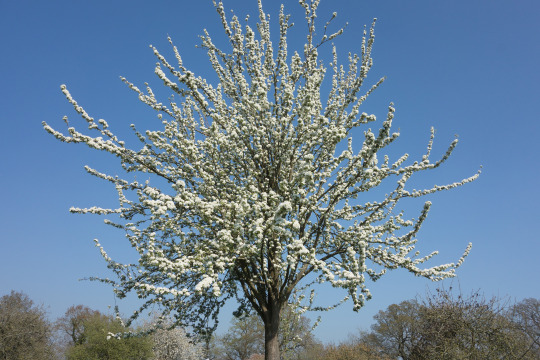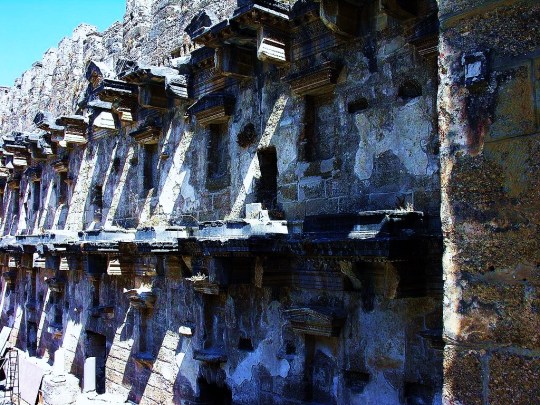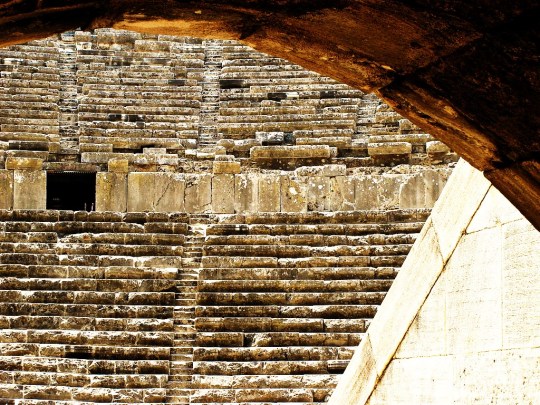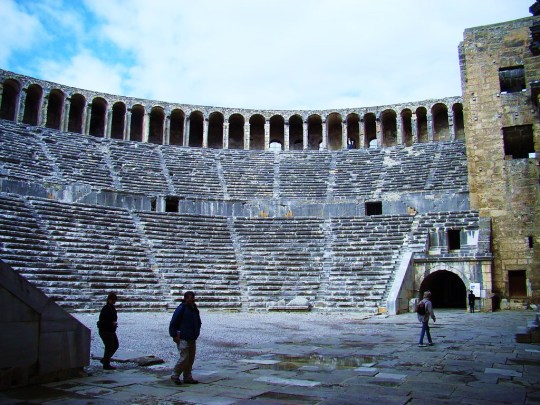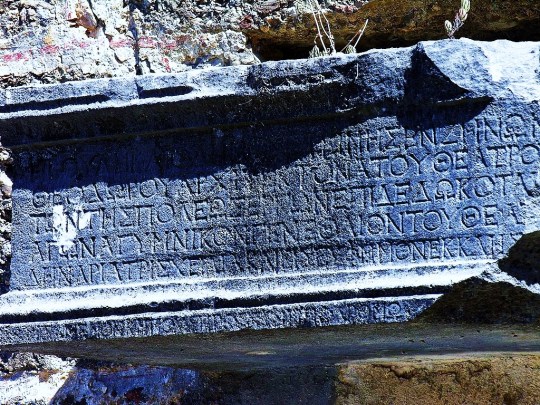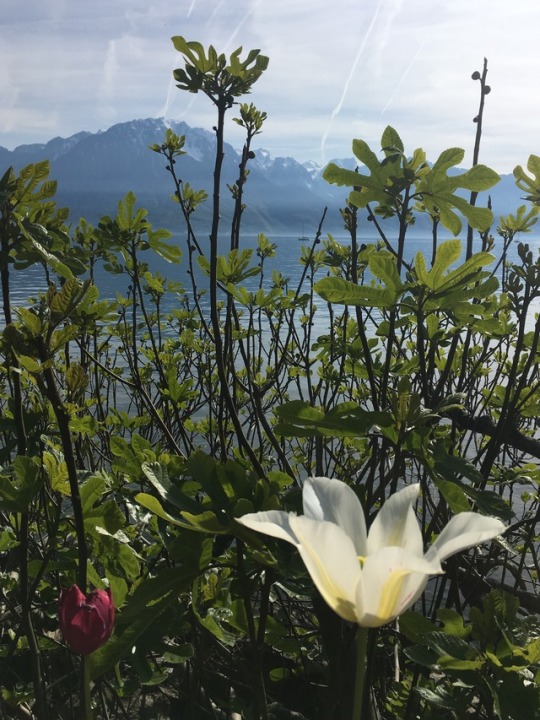Text
Butter. In a way you’ve never seen it before! Or more like the interesting history of it!
Butter, fortunately, still exists. Likewise other dairy products we(Turks) or the Mongols might have had a share in its invention as well as its dispersion. Yet, butter was already known both in Mesopotamia and Egypt. In these civilazitions’ ruins, we can see some drawings of the vertical butter churns, in contrast with the horizantal butter churns which are still being used by the Mongols. But they (Mongols) too might have had taken this food from the nomads surronding them. As a matter of fact, in a papyrus, B.C. 1800, an Egyptian writes about the butter and cheese given to him by a person,probably bedouin, he met in the Sinai. Nevertheless, butter, haven’t followed a path from south to north throughout its global dispersion journey. On the contrary, it came down from north to south. Because it is thought that things with similar names appeared in the Greek and Roman culture, however butter have never been widely consumed, then. That is why the Greek belittled the nomaidc, animal breeding and butter loving Scythians. The ease of cattle raising throughout the rainy meadows in which the Vikings have scattered around (including Iceland) makes for butter to be a Viking invention as well. It wasn’t until the middle ages that the butter produced from cow milk, by the Vikings, and the butter produced from goat milk, by the southern nomads, were to meet in the continent of Europe, residing in the middle of them. However, once the meeting happened butter clung immediately, especially in the north. Mediterranean merchants had the habit of carrying their olive oil with them when travelling to north, for merchandising, as they believed butter to cause leprosy.
The Northerners’ approach to olive oil weren’t much different from that. However, since the Pope himself was southerner, the authority was opposed to butter and this rivalry, bizarrely, even played a small role in the Reform Movement in Europe. For instance, a well-to-do northerner, during the days of fasting was to ask the Pope’s permission in order to consume butter (as it is an animal product). But they were to pay a small ‘forfeit’. It is said that the bell tower of the enormous Rouen Cathedral was built with these forfeit funds. Martin Luther could hint at (in his address to the German bourgeoisie, 1520) the Pope sending awful oils to the North and banning the butter consumption during fasting days. Eventhough, it might now be hard to believe, the conflict between these two fats, butter and live oil, was indeed big. Even more interestingly, when studying Europe’s religious beliefs map, after the days of Luther, we see that there are Protestansts in butter consuming regions and Catolics in olive oil consuming regions.(France, was divided between butter and olive oil sympathizers, as it was divided between the Catholics and Huguenots)
Moreover, the same map, shows clearly the differenenciation between the choice of wine and beer as favorite drinks. The exception is Ireland but when Ireland is in question the most powerful instinct is to believe in what the English belive in: ‘They eat butter, drink beer but believe in the Pope.’
Don’t fret and think that I argue that this important ideological difference(meaning, being Protestant or Catholic) should be reduced to the differentiation between butter/beer and olive oil/wine. Anyways, there are no norths and souths fot this matter now, everybody eats,consumes, everything. Yet, there is no harm in saying that there are interesting coincidences.
(translation by me, original version below)

And the original version of the text:
Tereyağı, neyse ki, hala var. Bazı başka süt ürünleri gibi bunun icadında veya yayılmasında bizim ya da Moğollar’ın payı olabilir. Ama gerek Mezopotamya’da gerekse Mısır’da, tereyağı bilinen bir şeydi. Moğollar’ın hala kullandığı yatay yayına karşılık, dikey olanlarının resimlerini de bu medeniyetlerin kalıntılarına görebiliyoruz. Ama onlar da bu yiyeceği çevrelerini saran göçebelerden almış olabilir. Nitekim İ.Ö. 1800’den kalma bir papirüste Mısırlı, Sina yöresinde tanıştığı – muhtemelen Bedevi- birinin kendisine getirdiği yağla peynirleri anlatır. Buna rağmen, tereyağı, dünya üzerinde çıktığı yayılma yolculuğunda, güneyden kuzeye bir rota izlemedi. Tersine, kuzeyden güneye indi. Çünkü Yunan ve Latin kültürlerine benzer bireylerin adı geçtiği sanılıyor, ama tereyağının hiçbir zaman yaygın bir kullanımı olmadı. Yunanlar, tereyağı düşkünü göçebe ve hayvancı İskitler’i bu yüzden aşağılardı. Vikingler’in yayıldığı(İzlanda dahil) bol yağışlı alanlarda geniş çayırlar olması, bu çayırlarda sığır beslemenin kolaylığı, tereyağını ayrıca bir Viking buluşu haline getirir. Onların yaptığı inek sütünden tereyağının ve güneyli göçebelerin yaptığı koyun sütünden tereyağının, arada kalan Avrupa kıtasında buluşması ta Ortaçağ’a kadar gerçekleşmemiştir. Ama bir kere gerçekleşince tabi hemen tutundu- gene özellikle kuzeyde. Akdenizli tüccarlar, tereyağının cüzama yol açtığına inandıkları için, kuzeye alışverişe giderken zeytinyağlarını yanlarında götürüyorlardı.
Kuzeyliler’in de zeytinyağına karşı tavrı bundan pek farklı değildi. Ama, Papa’nın kendisi güneyli olduğu için, otoritenin büyüğü tereyağına karşıydı ve bu rekabet, tuhaf bir şekilde, Avrupa’daki Reform Hareketi’nde bile küçük bir rol oynadı. Örneğin, hali vakti yerinde bir Kuzeyli, oru��( perhiz) günlerinde terayağı yemek için( ‘hayvani’ bir besin ya) Papa’dan izin alabiliyordu. Ama bunun için kiliseye küçük bir ‘ceza’ ödemesi gerekiyordu. Koskoca Rouen Katedrali’nin çan kulesinin bu ceza paralarıyla yapıldığı söylenir. Martiin Luther ise 1520’de Alman Soyluları’na hitabında, Papa’nın kuzeye berbat sıvı yağlar gönderip perhiz günü tereyağı yenmesini yasaklanmasına dokundurabiliyordu. Şimdi inanması güç gelebilir ama, bu iki yağ arasında çatışma öyle böyle değildi. İşin daha da tuhafı, Luther günlerinden sonra Avrupa’nın dini inançlar haritasına baktığımızda, tereyağı yiyen bölgelerde Protestanlar’ın, zeytinyağı yiyen bölgelerde Katolikler’in oturduğunu görürsünüz.( Fransa, Katolikler ve Protestan Hügnolar arasında olduğu gibi, tereyağcılar ve zeytinyağcılar arasında da bölünmüştür.)
Üstelik bu aynı harita, birinci içki olarak şarabı seçenlerle birayı seçenlerin ayrımını da oldukça net bir biçimde yansıtıyor. Belli başlı istisna İrlanda, ama İrlanda sözkonusu olduğunda, İngilizlerin inandığına inanmaktan daha güçlü bir içgüdü yok. Onlar tereyağı yiyor, bira içiyor, ama Papa’ya inanıyorlar.
Bu önemli ideolojik farklılığın( yani, Katolik ya da Protestan olmak) tereyağı/bira ve zeytinyağı/şarap ayrımına indirgenmesi gerektiğini iddia ettiğimi düşünüp telaşa kapılmayın. Hem zaten şimdi bu işlerin kuzeyi, güneyi kalmadı; herkes her şeyi yiyor. Gene de, ilginç rastanlılar olduğunu söylemenin sakıncası yok.
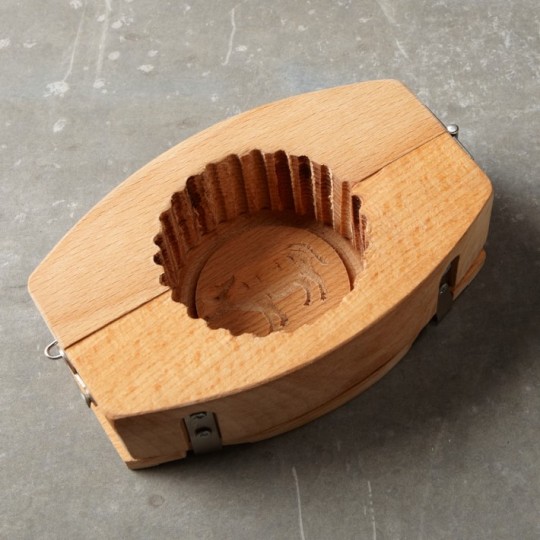
I found a bit strange that the writer didn’t include an explanation of the process of making butter. Since, he usually does in this book but I guess that will be in another post :D
Text taken from the book: Tarih Boyunca Yemek Kültürü
Written by: Murat Belge with the drawings of: Latif Demirci
Published by: İletişim Yayınları,2013
0 notes
Text
Did you know?
In Jiwali, a Australian Aboriginal language, they have four different words with four different significations whereas for us the word is just ‘us’:
1. ngali: the two of us including you
2. ngaliju: the two of us except you
3. nganthurru: all of us including you
4. nganthurraju: all of us except you
0 notes
Text
Aspendos Tiyatrosu/Antalya

‘Aspendos Tiyatrosu, büyüklüğü, sağlamlığı ve görkemli sahne binasıyla Anadolulu antik tiyatro yapıları içinde benzersiz bir örnek. Antalya’nın Serik ilçesinin Belkıs Köyü yakınlarında bulunan antik Aspendos kentinde, 2. yüzyılda Marcus Aurelius döneminde(161-180) inşa edilen bu anıt-yapının hoş bir hikayesi var: Aspendos kralının kızı Belkıs’ın evlenme çağı gelir. Kral, kızını şehrine en güzel armağanı verenle evlendireceğini ilan ederek bir yarışma açar ve bu yarışma sonucunda Aspendos sukemerini birinci seçecekken, bir de bir tiyatro inşa edildiği haberini alır; yeni tiyatroya gider, basamaklara oturur. Birden, ‘Kral kızı benim olmalıdır’ diye bir ses duyar. Sahneye baktığında, aslında tiyatronon mimarı Zeno’nun kendi kendine konuştuğunu görür. Akustik o kadar mükemmeldir ki, fısıltılar bile tiyatronun her yerinden rahatlıkla duyulabiliyordur. Aspendos kralı, kızını sonunda bu mimarla evlendirir. Hikaye ne kadar doğru bilinmez ama sahne binasının güney duvarındaki konsol üzerindeki yazıttan yola çıkarak yapının mimarının Theodoros’un oğlu Zeno olduğunu biliyoruz.
15-20 bin kişilik oturma yerlerine sahip tiyatronon sahne binasi, ahşap sahnenin ve onun gerisindeki duvarı süsleyen heykeller ve sütunların dışında, neredeyse eksiksiz bir şekilde günümüze ulaşmış durumda. İki uçtaki merdivenler ve cavea(oturma yerleri) üzerindeki 58 sütun ve kemerden oluşan galeri ise onarım görmüş. Yapıda kullanılan ana malzeme kalitesiz bir tür konglomera olsa da oturma sıraları, döşemeler ve kaplamalarda mermer kullanılmış.
Gladyatör oyunları için de hizmet vermiş olan tiyatro, Selçuklular döneminde ikâmetgah olarak kullanılmış. Aleaddin Keykubat(hük. 1221-1237), sahnenin büyük merdiven kulesinin içini figürlü çinilerle kaplayıp köşk haline getirmiş. Atatürk, 1930′daki ziyareti sırasında tiyatronun onarılıp yeniden kullanılması direktifini vermiş. Günümüzde, her yıl düzenli olarak Uluslararası Aspendos Opera ve Bale Festivali’ne evsahipliği eden tiyatro,2008 yılında restorasyona alındı. Uzmanlar, konser ve etkinliklerin yapıya onarılmaz zararlar verebileceğini düşünüyorlar.’

1 note
·
View note
Text
Aspendos Tiyatrosu/Antalya
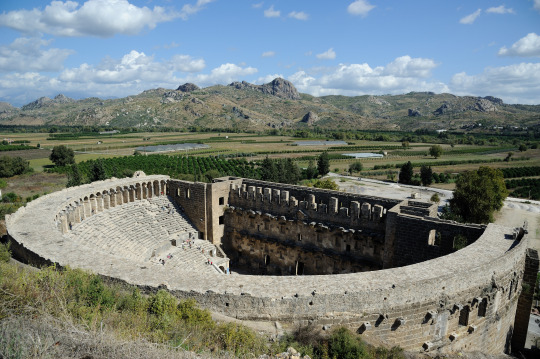
The Aspendos Theatre, with its durableness and its spectacular stage construction is an unparalleled example within the Anatolian antique artefacts. It is located in the then antique city of Aspendos, currently near the Belkis village in the Serikli county of Antalya.It was built in the 2. Century, back in the days of emperor Marcus Aurelius (161-180). The story goes that, the emperor of Aspendos, declares that he will marry his daughter ,Belkis, to the one who’ll give the most beautiful gift to the city. As he is about to choose the Aspendos aqueduct as the winner of his contest he hears the news of a theatre being build. He goes to the new theatre, sits on its steps and suddenly hears a voice saying, ‘The emperor’s daughter should be mine.’ When he looks at the stage he sees the architect of the theatre Zenon talking to himself. The acoustic of the theatre is so perfect that every whispering can be easily heard from any part of it. At last, the emperor marries his daughter to this architect.’
It is not known whether the whole story is true but we do know that the architect was indeed Zenon, son of Theodoros, based on the writings on the southern murals of the stage.
Except for its wooden stage and statues & columns decorating the wall behind the wooden stage, the theatre reaches today almost in its completeness, with its cavea offering 15-20 thousand seats. The two staircases in its opposite ends and the galleria, on the top of the cavea, composed of 58 columns and arches have been renovated. Though the fundamental construction material is conglomerate of poor quality marble was used for the benches, pavements and coatings.
The theatre has been used for gladiator fights and later on also as residence by the Seljukians. Aleaddin Keykubat (1221-1237) has transformed the big staircase tower of the stage into a pavilion by decorating its inside with ceramics. Atatürk gave the instructions to renovate and reuse the theatre during his visit to it in 1930. Presently, it hosts the annual International Aspendos Opera and Ballet Festival, some experts believe that the theatre could be critically harmed by spectacles.
(Translation by me)(The original is coming)
So there are a few thing that I’d like to add:
1. I dont’t know what impression they give in the photo but the seats are very comfortable and of course better with some cushions.
2.This passage is taken from the book: ‘Türkiye’nin Kültür Mirası: 100 Mimari Şaheser’ written by Meltem Cansever and published by NTV yayınları, Doğuş Grubu İletişim Yayıncılık ve Ticaret A.Ş..
3.Since the passage is from the 3. edition of the book, 2011. It doesn’t include this: It is part of the World Heritage List of UNESCO as from 2015.
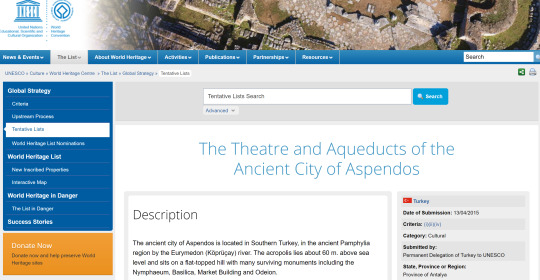

4. The ending of the passage confuses me because I couldn’t find any evidence of experts,not even in the official site of UNESCO, saying that the concerts and spectacles could seriously harm the theatre. And can’t see how ,except for vandalism or ill taking-care etc., since it was constructed as one and most of the antique amphitheatres are still being used throughout the world.
5. Other great thing about this theatre,if all of the above mentioned wasn’t enough, is that it is quite easy to reach from the centre of Antalya (which you must visit!!!!) which I would suggest that you stay or from the counties nearby where most of the holiday villages are located.
And you can visit the theatre all year long except from restoration times.
And it is quite near to another world heritage site: ‘Perge’.
http://whc.unesco.org/en/tentativelists/6036/
http://www.aspendosfestival.gov.tr/en/
https://en.wikipedia.org/wiki/Aspendos
https://www.britannica.com/place/Aspendus
0 notes
Text
Uyumak (To Sleep) Bedri Rahmi Eyüboğlu
To sleep
Sinking into the self that always waits Like a comfortable armchair in the corner Wound up like a ball in the middle of a brilliant day Not waiting for the evening’s alms to be cast before me For night to be sold at auction to the skies Nor hanging sleep like a bag of cats around my neck
To sleep
Resting my head on the knees of a summer noon Stretching my feet toward slumber Full of blue pebbles translucent deep
To sleep
Opening my dreams at the place of my desire Closing my them at the same time that I desire Following the self that fades as though it were the fleeting crane
To sleep
Stretchig full length in the middle of skies That smell of yellow roses Dropping the fragment of blues sky caught behind my eyelids Drop by drop into the darkness in my head
(Uyumak, by Bedri Rahmi Eyüboğlu, translated from Turkish by Nermin Menemencioğlu)
UYUMAK
Köşede rahat bir koltuk gibi Her zaman beni bekleyen Içine gömülüp Işıklı bir günün orta yerinde uyumak! Akşamin bir sadaka gibi önüme atılmasını Gecenin haraç mezat göklerde satılmasını beklemeden. Uykuyu bir arpa torbası gibi boynuma geçirmeden Uyumak!
Başımı bir yaz öğlesinin dizlerinde unutup Ayaklarımı mavi çakıl taşları dolu berrak Bir uykuya uzatarak: Uyumak!
Rüyalarımı canımın istediği yerinden açıp İstediğim zaman kapatarak Bir turna sürüsü gibi süzülüp giden içimin peşine takılarak Uyumak!
Sarı gül kokan göklerin ortasına boylu boyunca uzanıp Göz kapaklarımın arasında kalan masmavi bir gök parçasını Başımın içindeki karanlığa damlatarak Uyumak!
0 notes

